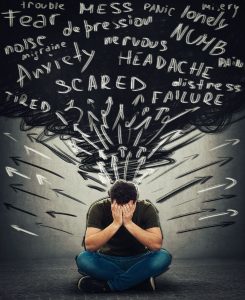This month, we’re beginning to explore the topic of anxiety as part of a 3-month series where we will dig into the What, Why, and How questions surrounding anxiety. In this blog, we will go over the “whats” of anxiety, to help our readers better understand the nature of anxiety and what it looks like in themselves or their loved ones. Anxiety is one of the most prevalent mental health issues and is also something that even if it’s not an issue in our life, there is hardly a person alive who has never experienced some level of anxiety.
What is Anxiety?
 The New Oxford Dictionary defines anxiety as “a feeling of worry, nervousness, or unease, typically about an imminent event or something with an uncertain outcome.”The American Psychological Association (APA) defines anxiety as “an emotion characterized by feelings of tension, worried thoughts, and physical changes like increased blood pressure.”
The New Oxford Dictionary defines anxiety as “a feeling of worry, nervousness, or unease, typically about an imminent event or something with an uncertain outcome.”The American Psychological Association (APA) defines anxiety as “an emotion characterized by feelings of tension, worried thoughts, and physical changes like increased blood pressure.”
Anxiety can manifest in many different forms. There are more cognitive aspects of anxious symptoms which are more worry and anxious thoughts. Then there are the more physiological signals of anxiety which are actual physical symptoms that can range from a feeling of uneasiness to heart palpitations, tightness in your chest, and several other symptoms that can turn into what is called a panic or anxiety attack.
It’s important to make the distinction that not everyone who feels anxiety is dealing with a clinical diagnosis of an anxiety disorder. Feeling worried or nervous is perfectly normal in many situations. While anxiety is a typical response to threatening situations, an anxiety disorder can cause feelings of panic when it’s not logical or rational to do so. When reasonable or perceived danger is detected by a person, the body releases adrenaline. This triggers a response known as fight or flight.
What is Fight or Flight?
The Fight or flight response (also known as your stress response) is a physiological reaction to a stressful or frightening event. During this, the sympathetic nervous system is activated, releasing hormones into your body, creating the urge to either run away or stay and fight, to defend itself from the perceived threat. This is often common in social situations, confrontations, or when a person is faced with major life changes or difficult decisions. Essentially your fight or flight response is your body’s survival response to real life or death danger but what happens with anxiety is your body is reacting to a feared or imagined stimulus as though it were a real danger and activating that same physical response- except there is no real at the moment danger!
What is an Anxiety Disorder?
Typically, when these instances occur, a person can move past them in a reasonably timely fashion. With clinical anxiety, these responses can become prolonged, disproportionate, and even more severe than the initial trigger.
 A person usually receives a panic or anxiety disorder when these symptoms increase enough to impact one’s daily life and functioning. Depending on the what the pattern of anxious symptoms will depend on which anxiety disorder is diagnosed. When there are recurrent panic/anxiety attacks, this is what is referred to as Panic Disorder.
A person usually receives a panic or anxiety disorder when these symptoms increase enough to impact one’s daily life and functioning. Depending on the what the pattern of anxious symptoms will depend on which anxiety disorder is diagnosed. When there are recurrent panic/anxiety attacks, this is what is referred to as Panic Disorder.
What Is a Panic or Anxiety Attack?
An anxiety attack is a physical response to nervousness or worry. A full panic attack is essentially when the fight or flight response we just mentioned activates and you have a surge of stress hormones in the body but no real danger so those hormones aren’t actually necessary. Usually, people start to breathe shallowly from their chest and this can lead to hyperventilation and a series of uncomfortable physical symptoms that can present as shortness of breath, palpitations, tightness in the chest, intense sweating, dizziness, and confusion among many other symptoms. Panic attacks can be caused by external or internal stimuli that trigger anxious symptoms. It’s important to note that while anxiety attacks can be distressing, both physically and emotionally, they do not cause any physical danger to the body.
What To Do When You Have a Panic Attack?
Panic attacks are a complex but VERY treatable symptom. There is a lot more we can say about how to treat panic attacks and we will in an upcoming blog but in the meantime here are a few quick tips:
- Pay attention to what your body needs. If you’re having trouble breathing, try to take slow, deliberate diaphragmatic breaths.
- Recognize that you can’t make anxiety or panic immediately go away. The more you try to control or force the symptoms away, the more they tend to increase so say a calming mantra to remind yourself that it’s just anxiety and can’t actually harm you.
- Go somewhere quiet, so that you can collect your thoughts. Rest if you can.
- Drink something cold or warm, to reset your senses. Be aware of the way it feels, and try to focus and ground on that feeling.
- Tell someone. If you’re in a setting where you feel comfortable sharing what you’re experiencing with someone else, do it. Feeling less isolated during an anxiety attack can help them pass more quickly.
What to Do if you think you have an Anxiety Disorder?
 Find a therapist. For many people suffering from anxiety, having a behavioral health therapist to talk to about coping strategies is the key to managing anxiety and anxiety attacks.
Find a therapist. For many people suffering from anxiety, having a behavioral health therapist to talk to about coping strategies is the key to managing anxiety and anxiety attacks.
Talk to a medical professional. Your primary care physician will be able to talk through different medication options for you that can help treat the symptoms of anxiety. They can also work with your therapist to find the combination of treatments that is most effective for you!
Tell a trusted friend or family member. Talking through your symptoms and the way anxiety is affecting you can be very healing, and having someone who is a part of your everyday life check in on you can help combat the feelings of loneliness and hopelessness that anxiousness can bring.
Begin Anxiety Treatment in Tampa, FL
Finding the right therapist can take time. Our team understands this and would be happy to offer support with coping with the anxiety symptoms affecting you most. We are happy to help individuals across Tampa, FL, and online across the state. You can start your therapy journey with Wellness Psychological Services by following these simple steps:
- Contact Wellness Psychological Services
- Meet with a caring therapist from our team
- Start getting the support you deserve in overcoming anxiety!
Other Services Offered with Wellness Psychological Services
Anxiety treatment isn’t the only service our team offers at Wellness Psychological Services. We are happy to provide support for a variety of mental health concerns through individual and group therapy. Other services offered include support for couples, divorce discernment, support through divorce, and mediation for couples. We are also happy to provide mental health support via group therapy, trauma therapy, depression counseling, OCD treatment, stress management, and testing and evaluation services. In addition, we also offer support with eating disorder treatment, PCIT therapy, DBT, child therapy, therapy for professionals, and health psychology. Feel free to learn more by visiting our blog page or FAQ!

